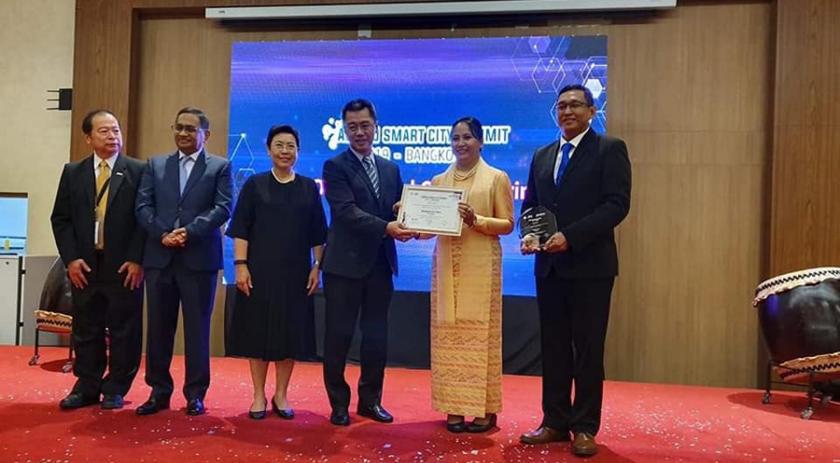
YANGON—In the midst of a high-tech makeover to become a genuine smart city, Myanmar’s historic royal capital Mandalay—more than 160 years old—received the Smart City Award 2019 at a Bangkok summit attended by 24 countries including Japan, India, Australia, Singapore, Taiwan and Thailand.
“We have been effectively changing municipal services by using technology, and these changes have progressed rapidly in a short period of time. This is the main reason we received the award,” U Ye Myat Thu, Mandalay’s smart city officer and Mandalay City Development Committee (MCDC) member, told The Irrawaddy.
The summit was organized by the Asian-Oceanian Computing Industry Organization (ASOCIO), a federation of information and communications technology (ICT) industry associations in the Asia and Oceana region. It includes member organizations from 24 countries including Japan, India, Australia, Singapore, Hong Kong, Taiwan, Philippines, Thailand, Indonesia and New Zealand.
The annual ASOCIO summit is attended by experts, governments and inter-governmental organizations from member countries seeking to promote e-government systems and the use of digital technology for the sustainable development of smart cities.
ASOCIO pronounced Mandalay recipient of the Smart City Award 2019 for achieving the rapid development of its public services through the use of advanced technology.
The Mandalay City Development Committee (MDCD) has been chasing the smart city dream since 2017, a year after the National League for Democracy (NLD) took office. The committee has drawn up a 30-year urban development plan with a vision of improving the water supply, wastewater treatment and solid waste management systems using smart technology.
For a couple of years now, the city has been installing sensors to keep real time traffic light records and to monitor traffic congestion through automated control centers. The sensors also track the conditions of pipelines and water meters in real time to identify leaks. The city now uses a radio-frequency identification (RFID)-based system in a new electronic toll payment system.
Mandalay’s traffic technology, adapted from systems used in Singapore, adjust automatically based on congestion levels.
The city has already installed 100 meters that government employees can read remotely using a smart phone app and drawn up a waste management plan to maximize trash collection and promote the three Rs—reduce, reuse, recycle—by setting up designated public bins and promoting their use in schools. The MCDC has affixed to the city’s garbage trucks GPS tracking devices that monitor routes and alert control centers of deviations.
Construction on a wastewater treatment plant concluded in July, and it’s currently cleaning the waste water of 26 Mandalay factories.
Last year Mandalay was ranked by CIO Asia fifth among the top 10 cities in Southeast Asia in the process of becoming “smart cities,” a ranking based on information from The ASEAN Post, The Economist Intelligence Unit, the network’s own project profiles and Govlnsider.
MCDC said there are many planned projects to be introduced to the public this year such as an online payment gateway system for municipal bills and taxes, a drainage master plan to solve road flooding, standard mapping and zip codes to easily find any location in Mandalay, artificial intelligence for crime-monitoring video surveillance systems, and producing gas from decomposing trash.
“We are waiting on the approval from the central bank for the online payment system. As soon as the central bank approves our proposal, citizens won’t need to come to the office to make payments on property taxes, construction permits and other municipal taxes,” U Ye Myat Thu said.
Situated along the Irrawaddy River and near an active fault line, Mandalay has always been vulnerable to floods and earthquakes, all the more so as the city rises and expands into low-lying areas.
To cope, it has been working with the Department of Human Settlement and Housing Development and the Japan International Cooperation Agency (JICA) on an urban development plan looking ahead to 2040. It aims to reduce flood risks and manage the city’s trash, water and wastewater systems with the aid of high-tech solutions, according to the MCDC.
Though the MCDC has already undergone a series of high-tech makeovers, U Ye Myat Thu said there are still many things to do to achieve full smart city status.
“IT Technology is advancing every day. It is an endless job to catch up. I hope we can lay the whole foundation for a smart city during our term,” he said.












